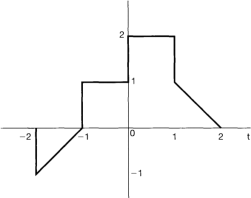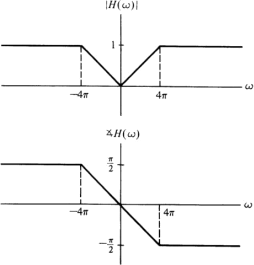CAN207 Continuous and Discrete Time Signals and Systems Assignment 1
Hello, dear friend, you can consult us at any time if you have any questions, add WeChat: daixieit
CAN207
Continuous and Discrete Time Signals and Systems
Assignment 1: CT Signals and Systems
Deadline: Nov. 6 th , 23:59.
Submission: Submit the electronic version to Learning Mall.
Information: This assignment takes 15% in the total mark.
Question 1 (20 marks).
A) A CT signal x(t) is shown in Figure 1:
1) Sketch x(6 − 4t) and x(t)[δ(t − 1.5) − δ(t − 2)];
2) Calculate the energy and power of x(-t) and determine whether x(-t) is a finite energy signal or a finite power signal.

B) A DT signal x[n] is given by x n = ne jπ4n 2 :
1) Is x[n] a periodic signal? If it’s periodic, find its period;
2) Is x[n] an even or odd signal? Given reason for your answer.
Question 2 (10 marks).
Determine which of the properties (causal, stable, linear and time-invariant) hold and which do not hold for the following CT and DT systems (conclusions only).
1) y(t) = cos(3t)x(t);
2) y(t) = x(t) + x( − t);
3) y n = x[4n + 1];
4) h(t) = (3e−t + e−2t)u(t);
5) h n = e jnπδ[n].CAN207
Question 3 (10 marks).
An important concept in many communications applications is the correlation between two signals. Let x(t) and y(t) be two signals; then the correlation function is defined as

The function φxx(t) is usually referred to as the auto-correlation function of the signal x(t), while φxy(t) is often called a cross-correlation function.
1) What is the relationship between φxy(t) and φyx(t)?
2) Suppose that y(t) = x(t + T). Express φxy(t) and φyy(t) in terms of φxx(t).
Question 4 (10 marks).
A) Compute and plot the convolution y(t) = x(t) * h(t), where:

B) Compute and plot the convolution y[n] = x[n] * h[n], where:

Question 5 (10 marks).
Use adders, multipliers, integrators, and delay units to draw the block-diagrams of:

Question 6 (10 marks).
A signal g(t) is produced by switching on a continuous-time signal v(t) for a limited time −0.5T ≤ t ≤ 0.5T.
1) How can one produce g(t) from v(t) in the time domain?
2) Let G(jΩ) and V(jΩ) are the Fourier transforms of g(t) and v(t). Derive an expression for G(jΩ) in terms of V(jΩ).
Question 7 (10 marks).
Consider the system shown below, where the frequency response has magnitude and phase shown on the right. If

Write an expression for y(t).


Question 8 (10 marks).
Let X(jΩ) denote the Fourier transform of the signal x(t) depicted below.

5) Sketch the inverse Fourier transform of Re{X(jΩ)}.
Note: You should perform all these calculations without explicitly evaluating X(jΩ).
Question 9 (10 marks).
Determine the Fourier series representations for the signal shown below:

2023-10-31
CT Signals and Systems